The sanatana faith is one of those religions with a rich heritage of gods, each holding unique powers and purposes.
From the fierce strength of Lord Shiva to the nurturing presence of Lord Vishnu, and the divine energy of Goddess Durga, every deity has their own role in shaping the universe.
It’s no surprise then that people often wonder, who’s the most powerful god in Hinduism?
Is it Shiva, the ultimate destroyer and regenerator? Vishnu, the preserver and protector? Or maybe it’s Goddess Durga, who represents courage and divine energy?
The beauty of Hinduism lies in its diversity. Power isn’t just about strength. It’s about love, compassion, and the ability to guide and inspire.
For some, the most powerful god might be the one they connect with the most deeply.
So, is there truly one god who stands above the rest? Or is the idea of power in Hinduism more complex than that?
As a culture that values strength as an important element, the debate about the most powerful Gods is still an ongoing one.
Let’s dive in and explore what makes this question so fascinating.
Top 10 Most Powerful Hindu Gods

1. Lord Shiva
Lord Shiva, a deity in Hinduism, is a manifestation of the Ultimate Reality. The Sanskrit translation of Shiva's name is "cleansing and destroying." In Hindu mythology, Shiva is portrayed as the Destroyer in the Trimurti.
He is the god of the Yogis and is often shown as an all-knowing Yogi living an ascetic life on Mount Kailash. There are many names for Shiva, including Mahadeva, Pashupati, Bhairava, Vishwanath, Bhole Nath, Shambhu, and Shankar.
Brass Lord Shiva Meditating Idol (4 Inch) Lord Shiv Murti - Silver Plated (8 Inch)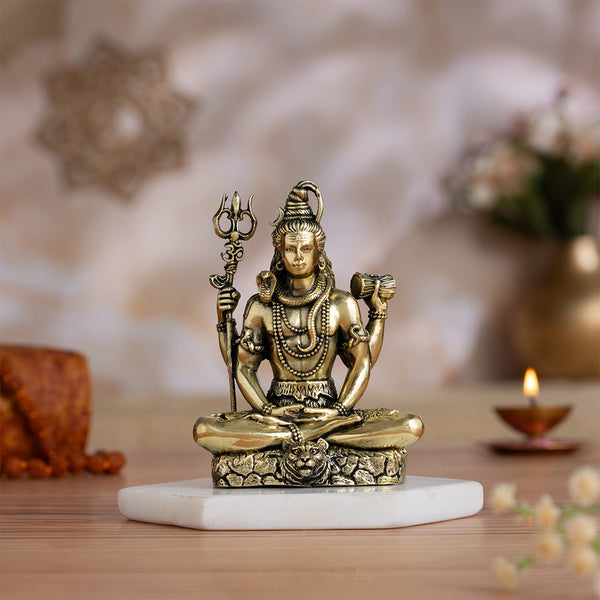

The Lord of Dance, a face of Lord Shiva goes by the name Nataraja. Lord Shiva is set apart from other deities in Hindu temples by a special shrine called a Shivling.
Lord Shiva is the God of Death; his name, Sayambu, means "not born of man," and refers to the fact that Shiva was formed rather than born.
One of Hinduism's most revered deities, Lord Shiva is also credited with overseeing the final stages of creation's demise as its appointed destroyer.
It is believed that Lord Shiva protects his devotees from harm and gives them the strength to control their baser emotions like lust, greed, and fury.
2. Lord Vishnu

One of the most important deities in Hinduism is Lord Vishnu.
As one-third of the Hindu trinity, the Trimurti, he is known as the protector of the universe, while Shiva and Brahma are responsible for the destruction and creation of the universe, respectively.
Lord Vishnu resides in the ocean of Kshir Sagar. Lord Vishnu is depicted as lying on the serpent Sheshnag.
Lord Vishnu's navel sprouts a lotus, the flower most closely associated with Goddess Lakshmi; Lord Brahma sits atop the lotus. It is believed that Vishnu slept off in the void before the Big Bang.
Lord Vishnu is often depicted in popular culture as different avatars. Because he is the protector of the universe, his incarnations are responsible for keeping the world safe from evil and for keeping the peace.
There are nine incarnations of Vishnu. His tenth incarnation, Kalki, is thought to present himself during the end of days. He is carried aloft by Garuda, the legendary bird.
Lord Vishnu Standing Antique Idol (12 Inch) Brass Standing Lord Vishnu Murti (6 Inch)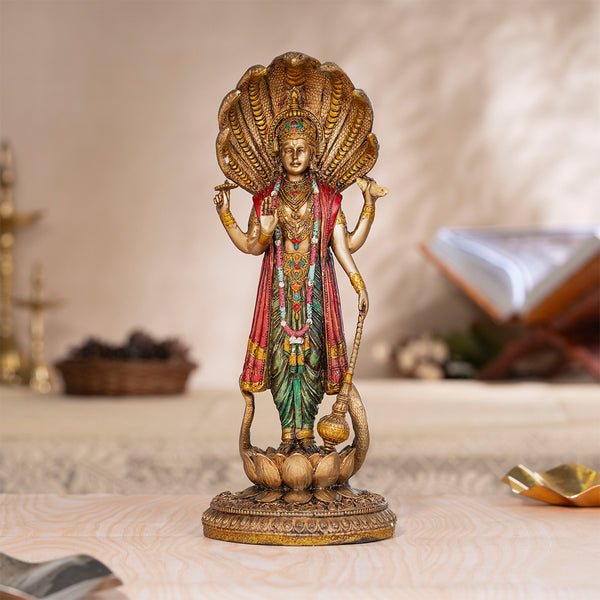
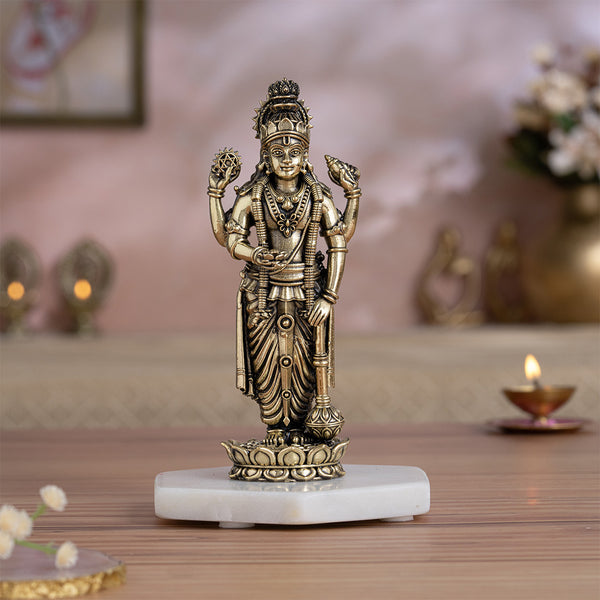
Vishnu is revered as the God of the Universe because of his role as its Keeper and Guardian. It is thought that Vishnu will return to Earth during times of great turmoil in order to right the wrongs of the world.
Many people think that Lord Vishnu will take one more incarnation before the end of the world, making his total number of incarnations ten.
Within the Trimurti, the trinity of Absolute Divinity that also includes Brahma and Shiva, Lord Vishnu is considered to be the highest deity.
3. Lord Ram

Lord Rama is one of the greatest Hindu deities, and he is also the seventh incarnation of Vishnu. Lord Ram is the king of Ayodhya and the eldest son of Kaushalya and Dasharatha. Later, Lord Ram got married to Sita, the daughter of King Janaka.
The Hindu god Rama is held in the highest esteem. Lord Rama was born in the Treta Yuga, one of the four cyclical Yugas described in sacred writings.
The Ramayana centres on Lord Rama, the story's protagonist. One of his stepmothers, Kaikeyi, plotted to have him exiled so that her son would succeed as monarch. As a result, Lord Ram, his wife, and his brother Laxman were exiled for 14 years.
Ravan, the King of Lanka, was overwhelmed by desire and wicked impulses, and he kidnapped Sita when the couple was in exile. This set off the battle that Ram won after confronting Ravan.
Childhood Form of Lord Ram - Gold Plated (6 Inch) Svastika Ram Darbar Pocket Temple - Gold Plated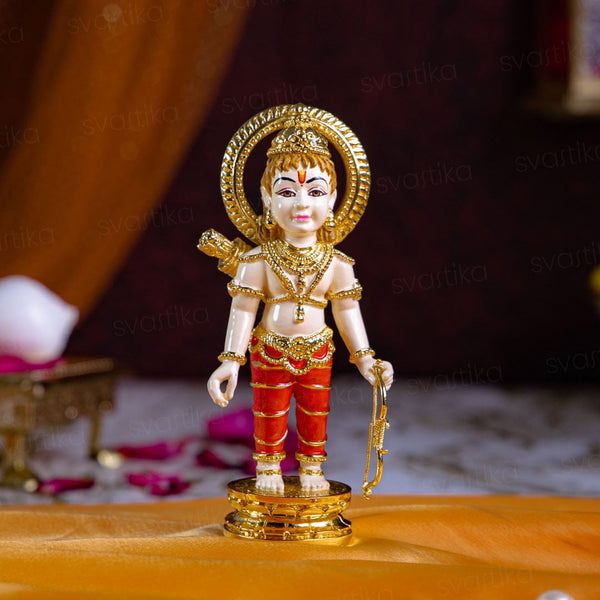
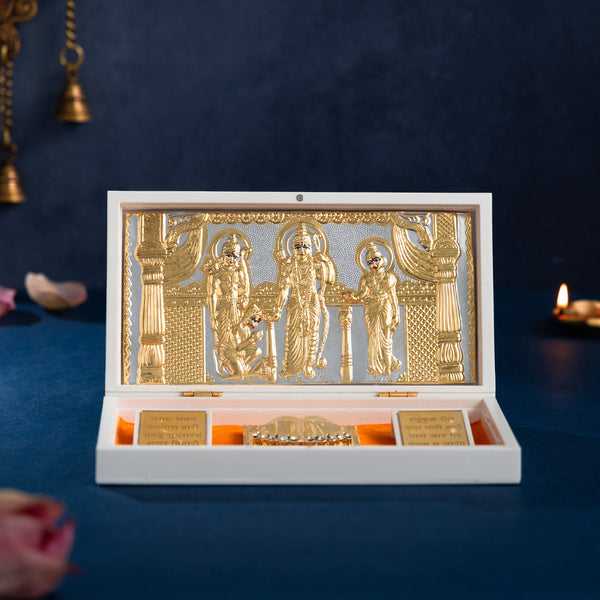
During a fourteen-year exile, Lord Rama eventually returned to Ayodhya and assumed the throne. Diwali, the most well-known Hindu festival, honours Lord Rama's rebirth after being banished.
Lord Rama had two sons, Lava and Kusha after he and Sita parted ways. Lord Rama's reign is still celebrated as the Rama Rajya since he was such a deserving monarch.
Once Lord Rama and his brothers had established their rule over Ayodhya, they set their sights on Jal-Samadhi on the Sarayu River.
4. Lord Brahma

Brahma, one of the most revered Hindu deities, is the Hindu religion's creator, lives in the heavenly realm of Brahmaloka, and is sometimes shown as having four heads to represent the four cardinal points.
It is said that Brahma originally had five heads, but that Lord Shiva severed the fifth one due to his pride.
Lord Brahma, a major Hindu deity from roughly 500 BCE to 500 CE, was eventually eclipsed in prominence by Vishnu, Shiva, and the great Goddess (in her multiple aspects).
Brahma, also known as Prajapati in Vedic mythology, is the god of creation who hatched from a golden egg and made the world. According to later legends, he was born from a lotus that was launched from Vishnu's stomach.
Around the middle of the first century AD, an attempt was made to reconcile the conflicting sectarian traditions through the theology of the Trimurti, which considers Vishnu, Shiva, and Brahma as three manifestations of the supreme unmanifested deity.
During the seventh century, Brahma was no longer seen as the ultimate deity, notwithstanding the Trimurti's ongoing prominence in text and sculpture.
There are currently very few Brahma temples and no Brahma-only groups. Nonetheless, most Shiva or Vishnu temples also feature a statue of Brahma.
Brahma is shown in art with four faces to emphasise his quadruple capacity. Many depictions of him include him carrying a book, prayer beads, a bow, and an alms bowl in his four limbs.
He might be sitting on a goose, a lotus throne, or both. Savitri, the embodiment of devotion, and Goddess Saraswati, the embodiment of music and knowledge, are his frequent companions.
5. Lord Ganesha

One of the most revered and foremost Hindu deities is Lord Ganesha. His other names include Vinayaka and Ganapati.
Ganesha is the son of Shiva and Parvati, and the brother of Kartikeya. Lord Ganesha personifies the Buddhist triad of Buddhi (knowledge), Siddhi (spirituality), and Riddhi (prosperity).
Lord Ganesha is depicted as a human with an elephant's head. He is frequently depicted with an extra set of hands, which he uses to hold a noose and a goad. One of Lord Ganesha's lower hands is in the Abhay Mudra, while the other lower hand holds a bowl of modaks. Lord Ganesha rides on a mouse.
Dagdusheth Ganpati Murti With Chowki For Home - Gold Plated (7 Inch) Brass Ganesh Idol Virajman On Sinhasan (4 Inch)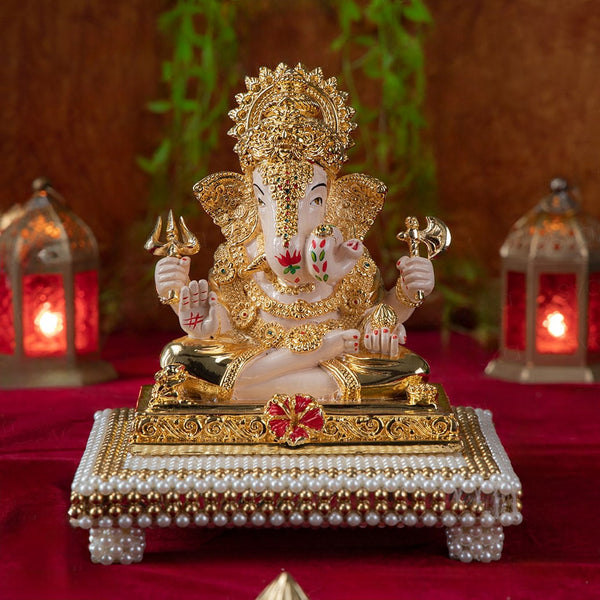
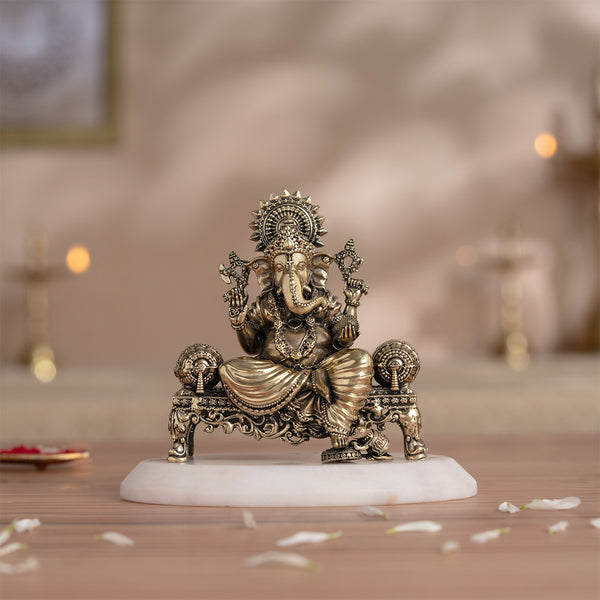
Worshipped at every new beginning, Lord Ganesha is one of the greatest Gods in the world, and while he has many facets, he is most easily recognised by his elephant head and a broken tusk.
He is revered as the supreme deity because followers believe he imparts the most beneficial wisdom and bestows unending good fortune upon them. He is the God of Intellect and Wisdom, and he supports many different fields of study.
It is believed that Ganesha Idols with a left trunk bring in positive luck and fortune. Idols and statues of Ganesha are highly sought after because of their universal significance.
6. Lord Krishna

Well, who doesn’t know the charm of Lord Krishna? However, this twinkle-eyed Khanna also has a reputation for being the most potent deity in the universe.
Krishna transforms into Narayana to appear before Arjuna, according to Hindu mythology. Narayana is the supreme deity who aids humanity in overcoming its ties to the past.
Vaishnavas believe that Narayana is the one and only truth, the creator and destroyer of the universe. The Bhagavad Gita explains that Lord Krishna is the Supreme Entity that possesses all wisdom, all power, all renunciation, all splendor, and all treasures.
Luxurious White & Gold Lord Krishna With Cow Idol (5.5 Inch) Krishna Standing Statue Antique Murti (10 Inch)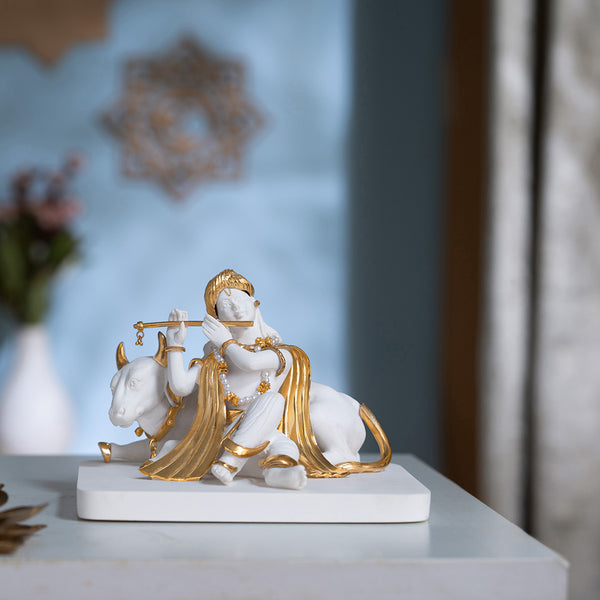
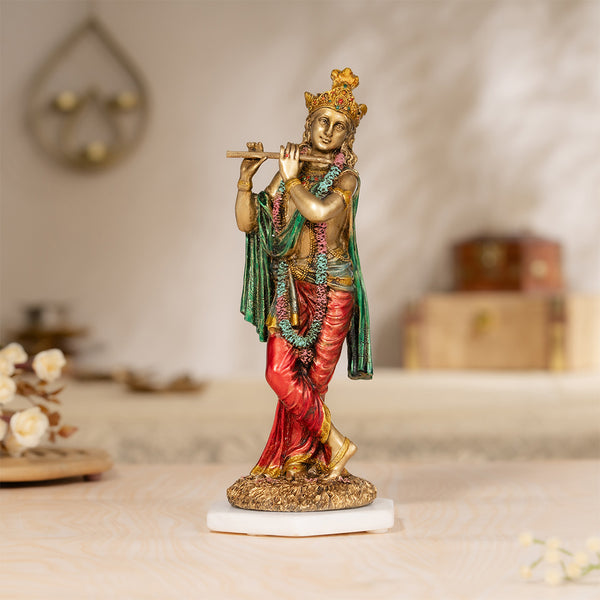
Some of Krishna's other names include Shri Krishna, Vasudeva, Govinda, Gopal, and Madhusudan. One of Hinduism's most admired philosophers and warriors, he is also the eighth incarnation of Vishnu.
Lord Krishna was raised in Gokul after his birth in Mathura. Lord Krishna spent his formative years with Radha and the other Gopis in the ancient forest of Vrindavan.
Most of his artworks depict him and his childhood sweetheart, Radha. Regardless of his fondness for Radha rani, Krishna never married Radha. Lord Krishna's wife was named Rukmini.
When Vishnu assumes a human body, it is always for a specific purpose. Lord Krishna came to Earth to end the reign of King Kansa and free the people of Braj from his tyranny. The conflict and its resolution were profoundly affected by Lord Krishna's participation in the Mahabharata later on.
Lord Krishna is easily recognisable in the various depictions of Him. Blue skin is a common color choice for depictions of Krishna. He is often seen playing the flute and accessorizing his yellow silk dhoti with a peacock feather tiara.
7. Lord Hanuman

Hanuman, the son of the deity Pawan or Vayu, is also revered as a major figure in Hinduism. He is one of the seven chiranjeevis, a group of seven immortals according to Hindu mythology. Legend has it that he resides on earth and will be around until the end of time.
Lord Hanuman is well-known for saving Rama's brother Laxmana by carrying an entire mountain of Sanjiwani Buti, a life-saving herb, and has since been regarded as the symbol of devotion, despite the widespread belief that he once tried to swallow the Sun and, as a result, had his powers severely curtailed.
The Hindu religion holds the monkey god Lord Hanuman in high esteem. Famous for his unwavering devotion to Rama, Lord Hanuman is a pivotal figure in the Hindu epic Ramayana.
Legend has it that the Hindu god Hanuman was born on the workday of Chaitra Purnima, just after sunrise in the city of Mangalwar. Mesha Lagna and Chitra Nakshatra were present at his birth. Those who worship Lord Hanuman are known as Hanuman Bhaktas.
For all intents and purposes, Lord Hanuman is a Brahmachari. He supposedly made a vow to devote the rest of his life to being a chaste celibate devotee of Lord Rama.
Brass Hanuman Idol Blessing in Abhaya Mudra (3.5 Inch) Panchmukhi Hanuman Statue With Orange Enamel - Gold Plated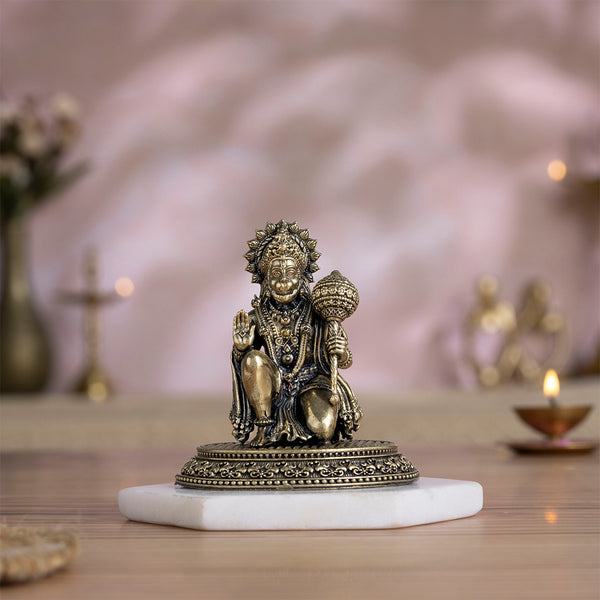
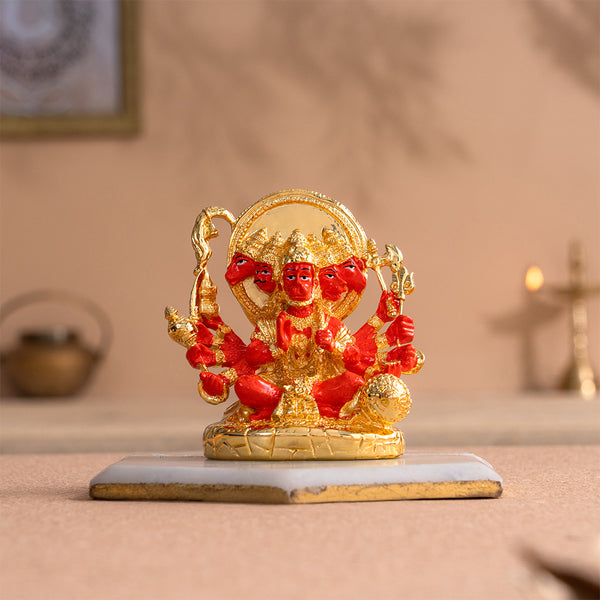
So, Lord Hanuman is the most revered god by those who have taken the vow of celibacy, especially the men among them.
Panchamukhi Hanuman is one of the more well-known reincarnations of the Hindu god Hanuman. Legend has it that when Lord Hanuman was in his Panchamukhi form, he defeated the demon Mahiravana.
Lord Hanuman is depicted as panchamukhi, or having five faces, with Shri Varaha facing north, Shri Narasimha facing south, Shri Garuda facing west, Shri Hayagriva facing the sky, and Shri Hanuman himself facing east.
8. Lord Kartikeya

Lord Karttikeya is a popular figure in Hindu mythology. Murugan, Subramaniam, Sanmukha, Skanda, and Guha were just a few of the names people called him.
His portrayal of Lord Murugan has made him famous in the southern parts of India. Many shrines to the deity can be found in the southern part of India.
Lord Kartikeya, also known as Murugan, was born according to a number of legends. Some religious texts allude to him as the offspring of Agni, the Hindu God of Fire.
The Skanda Purana, on the other hand, states that Karthikeya is Shiva and Parvati's older son. It is also speculated that Parvati did not carry Karthikeya to term. Rati, the Goddess's husband, and Kama (the God of Love), cursed her with infertility.
Lord Karthikeya is depicted as a youthful black man wielding a spear. He is a symbol of might and power, and he rides a peacock to show it.
One can achieve superhuman strength and overcome any obstacle by praying to Lord Karttikeya and receiving his blessings.
The peacock is a sign of His triumph over base urges and the destruction of all wickedness. Karthikeya represents the ideal of perfection and the necessity of striving towards it.
Kartikeya was born for the sole purpose of slaying the demon Tarakasura, and the Kritikas took him in and reared him away from his parents to keep him safe from the demons' assassination plots.
Kartikeya was given the position of king of heaven for his bravery and skill, but instead, he accepted the title of Commander-in-Chief of the Devas for his victory over Tarkasur.
9. Lord Surya

Surya, the Sun God, is revered in Hinduism. Although a number of other deities had solar characteristics throughout the Vedic period (1500–500 BCE), later Hinduism merged them all into a single god.
Historically, Surya was on par with Ganesha, Vishnu, Shiva, and Shakti, and he has many temples across India.
The Smartas are a caste of Brahmans (priests) that venerate these five gods, albeit only a subset of them, the Saura sect, consider Surya to be the supreme god.
However the vast majority of Hindus pray to him, and the Gayatri mantra is a common morning ritual for many Hindus since it honors the Sun.
Manu, the progenitor of humans, Yama, the god of the afterlife, the Ashvins, twin physicians to the gods, Karna, a great warrior from the Mahabharata, and Sugriva are all said to be Surya's progeny (king of the monkeys in the Ramayana).
According to the Puranas, a collection of Hindu mythology and legends, the gods' weapons were fashioned from pieces of Surya since his whole output was too dazzling to bear.
His influence was thought to be so great that it might banish night, heal all disease, and bring about universal illumination and heating.
10. Lord Indra

Among the primary and greatest Gods in Hinduism is Lord Indra, King of Heaven and Leader of the Devas, who is also a symbol of strength and courage.
The Hindu Deity Indra presides over the rain. Lord Indra, the offspring of Aditi and the scholar Kashyap is widely regarded as one of the most pivotal deities, but he is also frequently depicted as a sly and crafty God who deliberately sabotages the efforts of Devotees (and notably the Asuras) to appease the Gods.
Indra is a multifaceted deity in ancient religious literature. Cattle raids are led by him as king against the native dasas or dasyus who live in the areas his people travel through.
He's the god of thunder and lightning, and he's also a mighty warrior who vanquishes the demi-gods (asuras).
He also vanquishes an overwhelming number of supernatural foes, including the legendary dragon Vritra, head of the dasas and a demon of drought.
As a dragon, Vritra is blamed for taking the rains and water, as a dasa, for stealing cattle, and as an anti-god, for concealing the Sun.
The elixir of immortality, soma, which is offered to Indra at the sacrifice, gives him the strength to perform those deeds.
The cloud-dwelling, lightning-wielding Rudras (also known as Maruts) are among his companions. The term "the thousand-eyed" is used to describe Indra.
Conclusion

Born a Hindu, our bedtime stories included the incredible adventures of the Gods and Goddesses.
We adored Lord Krishna, felt awe at the presence of Lord Shiva, and wondered at the creations of Lord Brahma.
Pinning down just one of these Gods as the most powerful is belittling their strengths. While Lord Shiva is hailed for his powers of destruction, Lord Vishnu exerts his by keeping the entirety of the Universe safe.
Lord Ganesha remains the forefront deity during every auspicious occasion. Therefore, close your eyes, fold your hands, and pray to your heart's content.







